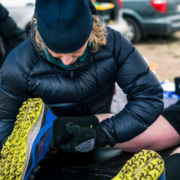By: John Fiore, PT
Winter in Montana can be a challenging time for runners in Montana. Winter is an excellent time to reflect on the past year and set realistic goals for the coming year. Winter in the time for runners to follow a solid strength training routine, build base miles, and partake in the many winter sports Montana has to offer. How can you reduce your injury risk when injuries impact nearly 80% of all runners (Br J Sports Med 2007)? While having a training plan is a good first step, four additional components will increase your running success in 2023. The four Ps (plan, perspective, preparation, persistence) will collectively reduce your injury risk.
Plan
Training plans can be found in abundance through local and online coaching. A realistic plan for the calendar year should center around a few key target racing goals. Fitness is composed of peaks and valleys. It is physiologically impossible to maintain peak fitness year-round. Divide your racing schedule into training races and peak races. Limit your peak races to a few per year, using training races to build fitness, experiment with nutrition, and identify areas of weakness. Allow yourself adequate time to recover from both training and target races to reduce over-training and injury risk.
Perspective
Missoula is full of experts in medical and training advice. Seek out those experts with experience in your sport. Utilize technology, but ask the question: “how will this technology improve my function?” At Sapphire Physical Therapy we utilize state of the art 2D video running analysis and accelerometers to objectively and visually evaluate your running stride. Interpreting your running data relative to proper and compensatory running biomechanics results in useful recommendations for improving running efficiency. Remember, the strongest predictors of future running injury include a prior history of running injury, running throughout the year without a break, and a rapid increase in running mileage of >10% per week (Br J Sports Med 2007). The key to effectively treatment and prevention of running injuries lies in accurately determining the cause of injury rather than treating the symptoms alone.
Prepare
Do the work, period. In the off season, strength training and cross training should be the focus. Train hard and recover well is a good mantra to follow. Recovery is as important as training and includes rest, nutrition, and sleep. If your performance is sub-par, re-evaluate your training plan and your goals. More is not necessarily better when it comes to training and running mileage. Recognize the signs of overtraining and fatigue and seek advice if you are not recovering in 1-2 days following a hard training effort. Failures are often more memorable than successes. Savor your training and racing failures as the life lessons they are and move on.
Persistence
Unless you are a professional athlete, I personally do not condone focusing on a single sport year-round. Maintaining fitness throughout the year is beneficial to all athletes regardless of age or ability. The winter off season is an opportunity to challenge and push your body in new and different ways to promote healing, strengthening, and mental freshness for the competitive season. Do not underestimate the importance of a consistent, strong mental game. A clear and focused mind will allow you to be honest in your training and running goals.
Patience
Every person responds differently to physical training and recovers at different rates. Understanding your body and what you need to adequately recover will reduce training errors and injury risk. Group training programs are great for comradery, but the group dynamic has potential consequences. Group intervals are an excellent way to maximize a high intensity workout. Group training runs when fatigued or recovering, however, may result in a workout which exceeds your body’s ability. Our body’s musculoskeletal system responds to physical demands (training, racing) by increasing tensile and muscular strength. If the body is not allowed adequate recovery between workouts, tissue failure will result. Building up mileage or intensity too rapidly has the same net effect. Be patient in your training to decrease injury risk. Here’s to an adventurous, challenging, enjoyable, and healthy 2023!





